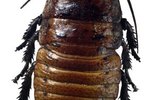Things You'll Need
Tape measure
Digital scale
Gloves
Centipede habitat
Centipedes are small, segmented arthropods that inhabit nearly every continent on earth. Arthropods belonging to the Chilopoda class of insects, centipedes can range from a few centimeters to well over a foot in length. Scientists have classified more than 8,000 individual species of centipede with archeological evidence dating the creatures back over 400 million years. Males and females of most species are very similar in appearance. Telling male centipedes from females can be a difficult task, but is essential for reproduction and to prevent territorial fighting.
Determine what species of centipede you are dealing with. It can be difficult to determine the gender of your centipede, but knowing what species you have will make determining gender simpler. Entomologists at most local zoos and universities will gladly examine your centipede to help you figure out the species of your centipede.
Look at the size of your centipede. In many species, the females are significantly larger than the males. Measure your centipede from head to the end of the tail and weigh it to get an accurate size of your centipede. A regular digital scale that displays weight in grams, like those used by bakers, works well for weighing centipedes. Compare the size of your bug to the average size of your species to predict the gender of your centipede.
Hold your centipede gently in your hand and examine the end of its tail. The sex organs in most species are located in the last few segments of the body and you may see a slight thickening in the tail of males in many species.
Check the terminal legs of your centipede. The terminal section is at the very end of your centipede, and in many species the terminal legs of the males are longer to aid in the mating ritual. Pick up your centipede and allow it to stretch out in your gloved hand to make this examination easier.
Place your centipede in its tank with another of the same species and watch how they interact. A male centipede will begin preparing a nest site for mating, often spinning a small web on which he will deposit a sperm sac. He will then engage the female in a series of movements to get her to pick up the sac and fertilize the eggs inside. Observing the mating process is the most accurate way to tell whether your centipede is male or female.
Tips
Watch your centipedes carefully when you place them together. Some species can be very territorial and may try to defend their space. If you notice any fighting, separate them to prevent injury.
Warnings
Never handle your insects without gloves. Most species of centipedes are venomous and their bites are very painful.
If you are bitten by a centipede, wash the area with plenty of soap and warm water to minimize the chance of infection. Apply a cold compress to the area to reduce swelling, and take an antihistamine to alleviate itching from the venom. You can also take a dose or two of pain relievers if the bite causes you too much discomfort.
References
Photo Credits
-
Hemera Technologies/Photos.com/Getty Images
Writer Bio
Louise Lawson has been a published author and editor for more than 10 years. Lawson specializes in pet and food-related articles, utilizing her 15 years as a sous chef and as a dog breeder, handler and trainer to produce pieces for online and print publications.





